[Table of Contents] |
[3. Workman's tools] |
[5. Design information management] |
[Table of Contents] |
[3. Workman's tools] |
[5. Design information management] |
| aspect of data handling | storage/browsing (DIM) | (1) | transport (file system) | (2) | processing (tool) |
|---|---|---|---|---|---|
| granularity | object-based | file-based | value-based |
While gap (2) is bridged by the input/output processors of design tools themselves, our encapsulation mechanism has to consider gap (1). As outlined in the Introduction, this encompasses
For control integration, our minimum requirement is that we have to be able to communicate an initial request for some activity from the framework to a design tool and to transfer notifications of activities on design objects between framework and tool. Despite this low level of control integration without intermediate requests being passed to the tool, there can be no general solution due to a lack of agreed standards in the area of tool control.
Even less can be achieved for presentation integration. As tools generally do not provide access to their internal object structures, it is by and large not feasible to combine browsers that work on framework data structures as well as on tool data structures. Integration in this area has to be achieved on a case-by-case basis. At least, due to the possibility to manage meaningful relationships between design objects in the design information management (DIM) component, useful browsers can be implemented on top of it.
Principle 3 of Section 2.10 prescribes that design tools be encapsulated into the framework. Yet, with purely file-based storage and transport, writing the appropriate tool wrappers can be quite lengthy and error prone due to the lack of standard behaviour on the side of design tools. The amount of work would simply be overwhelming if we attempted to bridge the gap between object-based storage and file-based transport in an equally ad-hoc manner. A new framework service is called for. This service replaces the UNIX shell conventionally used for programming wrappers for encapsulated tools. By looking again at the execution protocols introduced in Section 2.8, we conclude that such a service must be able to perform the following tasks:
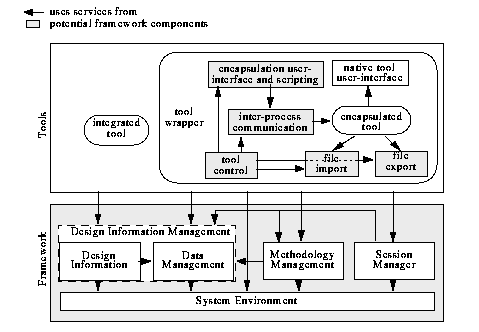
|
In this refined architecture, an encapsulated tool is augmented by a set of tool-specific adaptors. While the tool is not aware of its encapsulation into a framework, these adaptors connect to the public interfaces offered by the framework services in much the same way as tools that are directly integrated with these framework services would. From the framework point of view, an augmented tool behaves just like a tightly integrated tool. As suggested in this architecture, tool adaptors are considered tool specific and not subject to direct framework support. Thus, ad-hoc techniques prosper, giving little room to the reuse of adaptor code.
Our approach is to consider the adaptors needed for tool encapsulation as additional framework services. Code can be shared among tools with similar adaptor requirements. For example, all tools that interface to the design description language VHDL can reuse the same file processing adaptors. Encapsulated simulators can share the same inter-process link to a text editor that displays the source line currently executed. We conclude that adaptors for encapsulated tools should be part of the framework (Figure 8). While Figure 8 identifies the tasks addressed by the new tool encapsulation service, we will introduce a detailed component architecture in the next section.
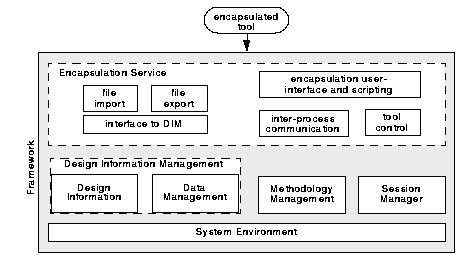
|
The main reason to select Tcl over CFI's choice Scheme ([CFI-EL 91]) is its modelessness:
"Tcl does not enforce any particular programming paradigm such as functional, logic, or object-oriented."
[Brannon 94], p. 12
The language is not to replace the framework's extension language but to supplement it with a language that is more familiar to tool integrators already being exposed to UNIX shell programming. Tcl was chosen over its competitors for the following reasons:(1)
Four additional syntactic constructs give the language a Lisp-like character:
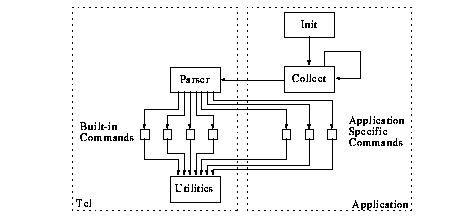
|
There is only one data type in Tcl: Strings. ASCII strings are used for commands, command arguments, results returned by commands, and variable values. Some commands expect one or more of their arguments to have one of the special forms of string: list, expression, or command. What makes Tcl extremely usable in our context is that it is easy to integrate into applications. The interpreter consists of a small library of "C" functions used to invoke Tcl commands, to bind "C" functions defined in the application to new Tcl commands, and to manipulate the values of Tcl variables (Figure 9).
We have extended the interpreter with new commands to fit it to its new task as execution protocol engine. Key to the extension is a module we added to make compiled object-oriented classes, written in "C" or "C++", accessible from Tcl scripts. Objects can thus be created, manipulated and deleted. The public features of compiled classes have to be registered to the Tcl interpreter. This is achieved either by invoking a schema programming interface or by feeding the interpreter a schema via extended Tcl scripts. The wrapper facility interfaces to objects through a small set of well-defined procedures which have to be implemented for each public member of a class. We have implemented a generator that wraps the more regular cases of public data members and member functions, constructors, and destructors of "C++" classes.
It is desirable to load the parsers for particular design description language into the encapsulation engine on demand. Thus, support for new languages can be added or existing modules replaced when requirements change. We have therefore added a facility that is able to load a module with compiled class definitions into a running encapsulation engine. Demand loading can be triggered while loading a schema for a compiled class into the Tcl interpreter.
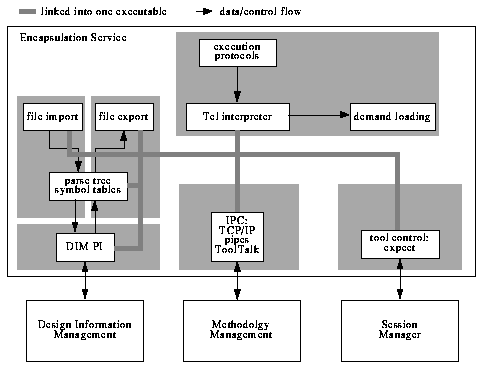
|
Other than the generic modules for the wrapping of compiled classes and for demand loading, the encapsulation engine is equipped with modules more specific to the task of tool encapsulation (cf. Figure 10):
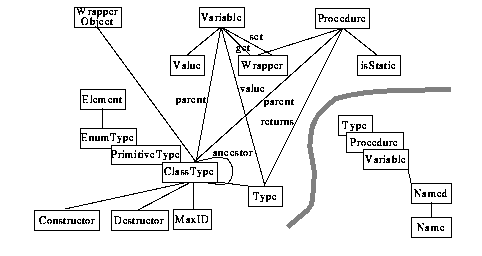
|
Every compiled object we want to handle from an execution protocol is associated with an object of type WrapperObject. A WrapperObject has a unique Handle and identifies its associated compiled object. Identifiers can be in-core memory addresses for "C" or "C++" objects, or database identifiers for objects residing in an (object-oriented) database(2). WrapperObjects are typed, that is, they are associated with a ClassType object.
As subtype of type Type, ClassTypes are named. In addition, they may have a number of data members (objects of type Variable) and member functions (objects of type Procedure). ClassTypes may also be involved in multiple inheritance by maintaining a list of ancestor-ClassTypes.
Variables and Procedures both have a Name and (value- or return-) Type, which can be either a ClassType, EnumerationType, or one of the PrimitiveTypes void, integer, boolean, float, or string.
WrapperObjects access data members and member functions of their associated wrapped objects via wrapper procedures written in "C". Data members are wrapped by associating them with a pair of wrapper procedures for read and write access. The set-Wrapper procedure may be omitted for read-only data members. Two different signatures are defined for these wrapper procedures:
typedef int (*Enc_Wrapper)
(Enc_Info* info, Enc_Identifier obj, Enc_Value& result,
int parmCnt, Enc_Variable parm[]);
Procedures of type Enc_Wrapper are used to wrap ordinary member functions or give read or write access to a data member. An object identifier is required.
typedef int (*Enc_StaticWrapper)
(Enc_Info* info, Enc_Value& result, int parmCnt, Enc_Variable parm[]);
Procedures of type Enc_StaticWrapper are used to wrap static member functions or constructors where no object identifier is needed as a parameter.
Using a purely procedural interface to wrapped objects has the advantage that even objects implemented in "C" may be wrapped. Only some kind of opaque handle mechanism is necessary which is a common concept in both operating system libraries (e.g. FILE*), and design data management systems (e.g. CELL_HANDLE, STREAM_HANDLE in Nelsis).
The implementation of this meta-schema facility provides a set of classes and member functions to easily define Types and associate them with Variables and Procedures. At run-time, each ClassType object maintains its extent in a hash-table to efficiently map from handles to object identifiers. The reverse direction is also supported: Whenever a new object identifier is encountered, maybe as a result of a procedure call or as value of a data member, that has not yet been assigned a handle, a new object handle is generated consisting of the class name and a unique number.
As the whole system is not persistent, object handles are only valid within a single session and are not suitable as object identifiers per se. It is, however, possible to override the standard handle generation procedure and use e.g. a persistent object id as handle. This is achieved by writing a new procedure
char* genId (Enc_Type* type, void* obj);
and registering it with the schema programming interface. Thus, handles may be made valid between sessions or among different instances of the encapsulation service and can be used directly as object identifiers in inter-tool messaging.
Now that we are able to describe types implemented in compiled modules, the next step is to be able to load such modules into a running execution protocol engine. New modules, e.g. for new or modified design description languages, can be added to the engine by the tool integrator on demand. No relinking of the engine is needed. The implementation relies on the UNIX library functions dlopen, dlsym, and dlclose to implement this feature. The only requirement on the demand loaded module is that it must contain position independent code. This can be achieved with a compiler switch.
Using a procedural interface to define a schema has little overhead but is complicated to use and difficult to maintain. We have therefore defined two new Tcl commands that allow to write schemas in Tcl. The commands translate the class definitions read from a schema definition file into procedure calls to the meta-schema facility. They also automate the demand-loading of compiled modules into the execution protocol engine. Here is the grammar for the schema definition language, using the syntax notation introduced in Section 3.2:
rule tcl_command {
tcl_builtin_command
| "enc_enum" IDENTIFIER "{" repeat { STRING_LITERAL } "}"
| "enc_class" IDENTIFIER opt { module:IDENTIFIER }
"{" opt { "inherit" repeat { class:IDENTIFIER } }
list { class_member }
"}"
}
rule class_member {
"constructor" c_proc
| "destructor" c_proc
| { "method" | "proc" } type_designator IDENTIFIER
"{" list { variable } "}" c_proc
| "public" type_designator IDENTIFIER get:c_proc opt { set:c_proc }
}
rule type_designator {
"void" | "int" | "float" | "boolean" | "string" | type:IDENTIFIER
}
What is most remarkable about this schema language is the handling of demand-loadable compiled modules as well as the use of "C" function names to associate procedures and data members with the appropriate wrapper functions. To automatically load a compiled module, a class definition may optionally name the location of this module in the UNIX file system. A table of already loaded modules is maintained so that a module is loaded only once. When the module name is omitted, the corresponding class definitions are assumed to be compiled into the engine. Naming "C" functions works in both cases. Whereas only fixed numbers of positional parameters are supported for ordinary methods, constructors and destructors are allowed to have arbitrary, named parameters. The schema programming interface allows both alternatives for either type of function.
rule class_command {
class:IDENTIFIER { object:IDENTIFER | "#auto" }
list { named_parameter }
| class:IDENTIFIER "info" { "inherit" | "heritage" }
}
rule named_parameter {
"-" parameter:IDENTIFER(3) typed_value
The result of executing a class command is a new object handle, either automatically generated or chosen by the programmer. In addition a new command is created in the Tcl interpreter that is used to invoke methods on the new object. A class command may fail if the underlying constructor function signals an error, e.g. because of conflicting lock requests. It is the responsibility of the wrapper function for the constructor to check the validity of any named parameters passed on the command line. A class command may also be used to retrieve the direct ancestors of the associated class from the schema data structure.
}
rule typed_value {
INTEGER_LITERAL | FLOAT_LITERAL
| BOOLEAN_LITERAL | STRING_LITERAL
| enum:STRING_LITERAL | OBJECT_HANDLE }
}
The purpose of invoking a constructor through a class command is not always to create an entirely new object. As the execution protocol engine maintains no persistent memory in itself, a constructor call is always needed to pull an object from a compiled module into the realm of execution protocols. In these cases the named parameters allowed on the constructor command line may pass selection criteria like names to the constructor implementation. The check-out of a design object in Nelsis could be regarded as a typical example of this. The Nelsis DMI returns a CELL_HANDLE which is used as an object identifier in the wrapper module. The destruction of the wrapped object using the standard message destroy on an object handle may then actually check in the design object. This application shows why destructors may have parameters in execution protocols, too. Nelsis requires a completion code to accompany the check-in operation.
Object handles need not be created with class commands. They can either be returned from procedures or be referenced through a data member of a wrapped object. The object handles are created the first time the procedure is invoked or the data member is accessed. The object handle can be used as value wherever an object of that type is expected. In any case, its value is also the name of a new Tcl command that is used to invoke methods on the associated object:
rule object_command {
object:IDENTIFIER "destroy" list { named_parameter }
| object:IDENTIFIER opt { ancestor:IDENTIFIER "::"(4) }
method:IDENTIFIER list { positional_parameter }
| object:IDENTIFIER "config"
repeat { "-" attribute:IDENTIFIER* typed_value }
| object:IDENTIFIER "info"
{ "class" | "inherit" | "heritage" | "proc" | "method" | "public" }
| object:IDENTIFIER "isa" class:IDENTIFIER
}
rule positional_parameter { typed_value }
Methods and data members are searched in the class of the object first and then, if not found, recursively upwards the inheritance hierarchy of the object class. A list of class names in exactly the sequence of method lookup can be retrieved by issuing the request info heritage. This default search can be overridden by prefixing a method name with the base class that defines the requested method. Data members can be set with the standard message config. A method with the name of the data member is automatically provided to read the value of a data member. Other standard messages exist to query the type data structures for certain information. The standard message destroy invokes the destructor with optional parameters. A short example illustrates the use of class commands and the manipulation of objects:
/* file: class.h */
struct base;
struct derived;
struct base {
int a;
char* s;
base* obj;
base(): a(0), s(0), obj(0)
{ printf ("base (0)\n"); }
base (char* s_): a(0), s(strdup(s_)), obj(0)
{ printf ("base (s='%s')\n", s); }
int incr (int i)
{ printf ("incr(%d)->%d\n", i, a+i);
return a += i; }
};
struct derived: public base {
int b;
char* t;
derived(): b(0), t(0) { printf ("derived (0)\n"); }
derived (char* s_): b(0), t(0), derived (s_)
{ printf ("derived (s='%s')\n", s); }
};
int add (base* a, base* b)
{ return a->a + b->a; }
/* file class.tcl */
enc_enum blubber { blubber waber glibber }
enc_class base libclass.so.1.0 {
constructor new_base
destructor del_base
method int incr { {int incr} } base_incr
public int a base_get_a base_set_a
public blubber soft base_get_a base_set_a
public string s base_get_s base_set_s
public base obj base_get_obj base_set_obj
}
enc_class derived libclass.so.1.0 {
inherit base
constructor new_bar
destructor del_bar
public int b derived_get_b derived_set_b
public string t derived_get_t derived_set_t
}
enc_class ex libclass.so.1.0 {
proc int add { {base a} {base b} } ex_add
}
Now we can create some objects:
% base b -s "aBase" -> base (s="aBase")
% derived d -s "aDerived" -> base (s="aDerived")
derived (s="aDerived")
% b config -soft glibber; d config -a 40
% ex::add b d -> 42
The last line shows the use of a static member function. Please note that enumeration values are quietly coerced into integers.(5)
enc_enum completionModeEnum {quit complete}
enc_enum openModeEnum {read write update}
enc_enum purposeEnum {edit import derive export extract view}
enc_class DesignObject {}
enc_class Library $DDMLib/schemas/libnelsis.so.4.3 {
constructor new_Library
destructor del_Library
method string query {{string query}} Library_query
method DesignObject designObject {
{purposeEnum purpose} {string name} {string viewType}} \
Library_designObject
...
}
enc_class DesignObject $DDMLib/schemas/libnelsis.so.4.3 {
destructor del_DesignObject
public Library lib DesignObject_getLib
public string mod_name DesignObject_getModName
public int v_number DesignObject_getVNumber
public string view_type DesignObject_getViewType
public string hierarchy DesignObject_getHierarchy \
DesignObject_setHierarchy
...
}
enc_class Nelsis $DDMLib/schemas/libnelsis.so.4.3 {
proc void init {{string tool}} Nelsis_init
proc void quit {} Nelsis_quit
proc void checkInAll {} Nelsis_checkInAll
...
}
Only some of the class members are shown here to demonstrate the use of the schema definition language. The data member hierarchy of class DesignObject is worth noting. Nelsis allows to access hierarchical relationships through the use of streams. The two wrapper functions DesignObject_getHierarchy and DesignObject_setHierarchy map this stream interface to an interface to a pseudo data member hierarchy. Whenever there is read access to this data member, the corresponding stream is read and its contents is returned as value of this data member. On write access, the string passed as parameter to the set procedure is written as new contents into the hierarchy stream. The class Nelsis collects functions that are not associated with any particular class. As such its member functions are static and do not pass an object identifier as parameter. A typical use of these classes in an execution protocol would look like this:
Nelsis::init browser_tools
Library lib -path ~/projects/DP32 -mode update
browse "DP32"
lib destroy -mode complete
Nelsis::quit
proc browse {mod_name {lv 0}} {
puts "[incr lv]: mod_name"
set q [lib query "GET DesignObject
WHERE Module ITS Name == $mod_name AND
Module ITS ViewType == 'structure'"]
if { [llength $q] == 1 } return
set do [lindex $q 1]
foreach h [$do hierarchy] { browse $h $lv }
}
This short Tcl program will open the Nelsis project "~/project/DP32" for update, and list the elements of the hierarchical composition of a Module "DP32". All the real work is done by the procedure browse, which prints the Module name passed as parameter and then searches for a DesignObject with Module name "DP32" and ViewType "structure" in the Nelsis database. The method query of class Library provides the interface to the Nelsis DML. It allows to pass queries as strings and returns query results as a Tcl list that are easily processed by Tcl commands. The first list element always contains the list of attributes requested, followed by a - possibly empty - list of results. The first DesignObject found is extracted from the list. A loop then iterates over its children in the composition hierarchy returned as value from the pseudo data member hierarchy, calling itself recursively with the Module name of that child.
[Table of Contents] |
[3. Workman's tools] |
[Table of Contents] |
[5. Design information management] |